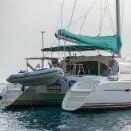Leaderboard
Popular Content
Showing content with the highest reputation on 19/02/17 in all areas
-
Although some of the responses weren't very helpful and one perhaps slightly rude, the only mysoginism is in your head. You would have received exactly the same treatment if you had been bloke. If I were a gas fitter I'd be reluctant to work for someone who seeks mysoginism at every turn where none exists. They would be concerned that any glitch, disagreement on the bill etc would come down to "it's because I'm a girl" and life is too short for that sort of rubbish. I suggest you refine your search only to female gas fitters, then this problem won't arise.3 points
-
Umm - computer says no.... If I understand you correctly, the two are like chalk and cheese (a poor analogy). Assuming this is not a wind-up - A V- belt has one V- shaped section across the width of the belt and 'cogs', I prefer the name 'toothed', which reduce the 'wrap' diameter of the higher speed pulley in the set up. This has two advantages - 1. The stress on the belt is reduced (= longer life) 2. Being more flexible, it means that the smaller pulley(s) in the setup can be umm- smaller, so that they spin 'faster', with the result that you can get more poser out of a given engine speed / alternator pair. A Poly-V belt has a number of Vs across the belt and is very much thinner, so it can power many devices at the same time. Have a look at any modern car... If it was a wind-up, then I'm well and truly caught.1 point
-
1 point
-
I mean no disrespect guys, but .... I have never used a guide in the himalayas. I have never used a guide in over 30 years of climbing, at a reasonable standard, all over the world. I know nothing about the severn estuary, nor the avonmouth tides, (which is why I asked) and of course I will do some research. I will ask on a sailing forum about navigation and pilotage in the upper reaches of the severn, like I asked on here about transiting canals. I asked about canals here because I know nothing about them, and quite fancy a go. I would have charts and tidetables for the severn, as I had whatever available maps, and route descriptions (when not attempting new routes) when climbing. I appreciate that someone taking a narrowboat down the severn estuary after only ever cruising canals, may require a pilot, seems like sense. But a small sailing boat most certainly does not require one, regardless of whether I know the area or not. I had no clue about the areas I have sailed in, until I went and had a look. I simply asked advice and took the charts and tide tables. Now, back to the canals, good pubs and great stopping off points1 point
-
We're going in circles David Mack needs to read it methinks1 point
-
Its the watts that in effect do the heating so as W = amps X volts any given current at 12V will be half the wattage of the same current at 24 volts.1 point
-
Yes, because, as your solution caters for admirably, it's an "all round look" that's required. An organic alternative might be to have an owl perched up forward - they're sharp eyed and outstanding at all round looks. Train it do screech once when steering to starboard is in order, twice for port, and don't be tempted to ignore him if he does five short screeches. I imagine there'll be very little loss of performance in a tunnels either. Edited to conform (thanks Howard)1 point
-
This one? https://www.beal.org.uk/automotive/switches-flasher-units/battery-isolator-switch-250a.html1 point
-
Another episode, for those still following the plot. After all the work, have we got what we hoped for? Blog link.1 point
-
Yes it *might*, but it doesn't. It's one of those theoretical possibilities that are a non-problem out therer in the real world. As Biz says, it might be a problem when used incorrectly, but that applies to a lot of things! Yes, this. I've been told by people this is the tape dissolving, possibly on here actually. It can easily be disproved by keeping a bit of PTFE tape in a jar of diesel for a few years and periodically getting it out for inspection... Getting back to the PTFE debris 'problem', bits of PTFE get left behind in the thread when dismantling a screwed joint previously sealed with PTFE. So if the joint needs to be re-made, the threads need carefully cleaning first.1 point
-
And from me happy birthday and all that. Isn't that a thoughtful post from the Boilerman, giving you the chance to hide next weekend1 point
-
This post cannot be displayed because it is in a forum which requires at least 10 posts to view.
-
1 point
-
I picked up a 3.5 metre length from pipecenter, which is twice as thick as that sold in most chandlers, mainly because all local outlets only supply 1.5 metre lengths which was too short. If you use them, ignore the list price and ask for a trade price - it will be considerably cheaper.1 point
-
I'm a bit late here but as a new boat owner who put the solar on during the 1st week, I have to say it was a good decision. AS has already been said, you don't get a lot out of them during the darkest winter months (I already knew this having a system on the house at home) but in the last couple of weeks, unless we are on board using "other power" - by that I mean than the fridge/freezer which is permanently on (12v btw) or water pump, the batteries have frequently been up to 100% according to the smartgauge. In a couple of months, I'd think we might even be able to use the immersion heater for half an hour in the morning to top up the tank and the solar will have put it back by the time I come home from work. What I would say is don't buy a ready made system or have it installed - paying through the nose. Do it yourself and save a lot of money... there are plenty of people happy to provide advice if you're unsure of anything.1 point
-
That's unlikely to happen if the tapes wound onto the thread in the correct direction for a R/H thread or for a L/H thread, with the correct tension and an 1/8'' or so back from the end of the fitting.1 point
-
Corgi gas fitters are 'by Royal Appointment'.1 point
-
Well I am enjoying it. It is easy to watch entertainment. Ok, some of the situations are contrived, just like most reality shows, but it is enjoyable none the less. I make the wife watch it in the hope that she may change her mind about boating and fancy having a go.1 point
-
With respect, I think as you have only watched 20 minutes out of the 120 minutes so far shown you are not in a position to make a fair judgement . I suggest you watch the whole series, then make a balanced assessment, that's what I will be doing.1 point
-
This post cannot be displayed because it is in a forum which requires at least 10 posts to view.
-
This post cannot be displayed because it is in a forum which requires at least 10 posts to view.
-
Another Nigerian prince died recently and left £20m to battersea dogs home. His solicitor said this was because no one would answer his emails.1 point
-
If transiting Teddington to the Wey there is no need to buy a one day licence, there is or used to be a special Wey transit license costing £10......1 point
-
Thanks folks. The boat has two alternators (standard Beta B43 set-up), one each for the (four) domestic and (one) engine batteries. When I think back, we've had the lights flickering with the engine running before, even when the domestic master switch was turned on. That's partly why I changed the switch today as realised it clearly wasn't always making a connection, and conversely I now think it also sometimes didn't properly switch off, even with the key removed (and the engine not running). I don't think we've fried anything, thank goodness, but I'll take the good advice and make sure never to have the engine running without both master switches 'on'. I was vaguely aware of that for the engine one, but not the domestic side. I'll have to look into a wiring diagram Tiggs. There may be one in the boat's documentation (however I don't think so) but I might struggle to draw one up myself. My dad was the electrician...! Thanks again folks. What a splendid lot you all are.1 point
-
This one keeps coming up and it takes a long time to get to the final answer because it depends on so many variables. I'll ask one of the mods to pin this so that we don't keep answering the same question. Will paralleling alternators reduce charge times? It depends upon:- 1. The size of the alternators in relation to the battery bank. 2. How far the batteries usually get discharged. 3. How fast the alternators are spun. 4. What other loads are being powered during charging. Answers. 1. and 2. If the alternators are very small (say less than about 15% of the battery bank size for each alternator) then paralleling them will almost certainly reduce charge times. There is a rule of thumb called amp.hour law charging (which is actually a play on what really goes on but it suffices for this purpose). This law states a battery will safely accept a charge current in amps equal to the number of amp.hours that need replacing. So a 400Ahr bank, at 50% SoC needs 200Ahrs replacing therefore it will accept a charge current of 200amps. After a short while that bank will have increased to 51% SoC, so now it will accept 196 amps. And so on. It can thus be seen that the idea of an alternator sized to 10% or 15% is complete crap. An alternator much bigger than this can be used and will result in massively reduced recharge times. If the batteries only ever get discharged to 90% SoC then at that state, the same 400Ahr bank will only safely accept 10% of 400 = 40 amps. So there is no point whatsoever in fitting an alternator bigger than this or in paralleling two 70 ampers. It would achieve nothing. But how many people only discharge to 90%? On a 400Ahr bank, with twin 70 amp alternators, parelleling them will almost certainly reduce recharge times. Anyone who says otherwise simply hasn't understood what is going on. 3. A huge problem on the inland waterways is alternators not being spun fast enough. Most marinisers (read engine painters) don't pulley the alternators up high enough. They have many excuses for not doing so, but whatever their excuse, it doesn't change the fact that they don't pulley them up properly. They might feel justified in leaving the alterntor spinning too slowly, they might be just saying things to justify their laziness in not being bothered to change the pulleys, but it doesn't change the reality. This isn't just my opinion, this is fact. Adverc reach exactly the same conclusion on their website. This means that the alternator does not produce anywhere near its full capability at tickover. If the engine is being run at tickover just to charge batteries then paralleling the alternators will almost certainly result in a massive increase in charge rate. On many off the shelf "canal boat" engines you typically double the charge curent at tickover by paralleling them. 4. A 70 amp alternator (even assuming it's pulley'd up properly) isn't going to put much charge into a battery if there is an inverter running at the same time pulling 71 amps from the batteries. In fact there will be a continual 1 amp discharge. In this case, paralleling up the other alternator will turn this into a charge. So you can see from the above that paralleling them can make a huge difference in many instances. Alternators don't "fight each other" if paralleled. During the bulk stage (ie when the extra current is needed) they both work at full hoot. When acceptance is reached (ie the regulation voltage of the alternators), one of them might shut down completely. This is no issue, it has only shut down because its charge current is no longer needed to maintain the battery voltage at acceptance. If its current was needed, it wouldn't have shut down in the first place because the voltage wouldn't have reached acceptance. If loads are put on that exceed the capability of the remaining alternator, then the other one will instantly fire back up again. Whether one alternator shuts down or not depends upon its regulator and in particular whether it is battery sensing (most external regs) or machine sensing (most internal regs). Machine sensing ones rarely shut down, battery sensing ones often do shut down. One issue that can rear its head is that the alternator shutting down can cause its charge warning light to come on and/or its tacho to stop working. This is a difficult (though not impossible) one to crack. With SmartGauge and SmartBank Advanced there is a feature built in to stop this happening. I see the external reg issue has come up again. With modern alternators they do nowt. Absolutely nothing. All they ever did was increase the charge voltage. That is it. The rest is marketing bullshit. Modern alternators already charge at the same voltage so adding one does nothing. Some mention the virtue of converting to battery sensing as this compensates for the losses in under sized battery cables and dodgy battery isolators. I maintain it is better to get rid of the losses that battery sensing tries to bodge its way round. This is achieved simply by replacing the battery cables with correctly sized cables and putting in proper battery isolators. When I used to actually wire boats up, as opposed to designing the equipment, I paralleled up literally hundreds of alternators, probably thousands. Every single one I did saw a reduced charge time of at least 20%, many as much as 30% and several by 50% or 60% Finally, don't think of it as paralleling the alternators. Think of it as paralleling the batteries. A subtle difference, but realise that, as a result of this subtle difference, if an alternator packs up, you will still get charge to both battery banks without lifting a finger. You can also emergency start the engine from the domestic bank via the split charge relay.1 point
This leaderboard is set to London/GMT+01:00
















